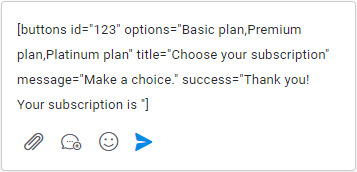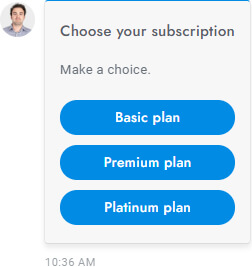Manage Conversations #
Conversations have a total of four different statuses: mark as read, archive, delete and restore. You can manage the status of a conversation by opening it in the conversations area and then clicking any of the corresponding icon buttons in the top right of the conversation window.
Search for conversations
You can for conversations by department ID, assigned agent ID, conversation title, conversation ID, message text, message attachments name, user first name, user last name, user email
Information
- When you empty the trash, all the conversations in the trash are permanently deleted.
- When a user sends a new message to an archived or trashed conversation, the conversation is automatically restored and will now be visible in the Inbox area.
- Trashed conversations are deleted automatically after 30 days.
- When a user is deleted, all the conversations and messages are permanently deleted too.
- An agent can delete their messages by opening the message menu and clicking Delete. The message menu becomes visible when you hover the mouse cursor over the message.
Text Editor and Automated Messages Features #
The text editor of the admin area and automated messages(example: welcome and subscribe messages) can be used to create stylized messages:
- Links formatting — All text links are automatically converted to clickable hyperlinks.
- Text formatting — The editor also supports text formatting syntax:
- To make text bold, surround it with *: *your text*.
- To make text italic, surround it with __: __your text__.
- To make text
strikethrough, surround it with ~: ~your text~. - To insert a single-line code comment, surround it with`: `your text`.
- To insert a
code block, surround it with “`: “`your text“`.
- HTML and other code languages — For security reasons, no HTML, JavaScript (JS), or other code languages are permitted. However, you can use HTML snippets by utilizing custom rich messages (discussed below).
- To insert a line break into a message, use the keyboard combination SHIFT + ENTER or CTRL + ENTER.
Merge fields
Merge fields are strings replaced by external values when used. Merge fields can be used in any message or automated message, including chatbot messages.
| Code | Description |
|---|---|
| {user_name} | Full name of the active user. |
| {user_email} | Email of the active user. |
| {agent_name} | Full name of the active agent. |
| {agent_email} | Email of the active agent. |
Rich Messages #
Rich messages are special messages with interactive features like buttons, dropdowns, or inputs. They allow an agent to request information from the user via a user input form or to diplay interactive contents. Rich messages can be inserted into a chat message using shortcodes. Shortcodes accept various parameters like title and description. The available rich messages are listed below.
How it works:
1
Create and send

Create a rich message by inserting the shortcode into the text editor of the admin area. Customize all of the parameters with your information and send your message.
2
Message is displayed

When a shortcode is used, the user sees the rich message (not the shortcode) and can select or enter the required information to complete the form submission.
3
User’s response is submitted

Once the rich message form has been filled out and sent by the user, a success message is shown and the form data is saved.
Rich Messages
| Name | Shortcode | Description |
|---|---|---|
| Card | [card image=”URL” header=”TITLE” description=”Lorem ipsum dolor sit amete” link=”URL” link-text=”Purchase” extra=”$599? target=”_blank”] | Call-to-action card with an image, title, description, link, and more. |
| Slider | [slider image-1=”URL” header-1=”TITLE” description-1=”Lorem ipsum dolor sit amete” link-1=”URL” link-text-1=”Purchase” extra-1=”$599? image-2=”URL” header-2=”TITLE” description-2=”Lorem ipsum dolor sit amete” link-2=”URL” link-text-2=”Purchase” extra-2=”$599? target=”_blank”] | Slider of call-to-action cards with an image, title, description, link, and more. You can add up to 10 slides. |
| Slider images | [slider-images images=”URL,URL,URL”] | Slider of images. |
| Chips | [chips options=”A,B,C”] | List of buttons. |
| Buttons | [buttons options=”A,B,C”] | List of buttons. |
| Select | [select options=”A,B,C”] | Dropdown list of options. |
| Inputs | [inputs values=”A,B,C” button=”Send now”] | List of text inputs. |
| [email name=”true” last-name=”true” phone=”true” phone-required=”false” placeholder=””] | Form to collect the user’s email and phone number. All attributes are optional. Follow up settings used as default values. Add the attribute required-messaging-apps=”true” to force users to provide their email and phone on messaging apps. Merge fields are supported. | |
| Registration | [registration] | Registration form. |
| Timetable | [timetable] | Timetable. |
| Articles | [articles link=”https://parrotgpt.ai/articles-demo”] | Articles with search area. The link attribute is used as fallback message for Facebook Messenger, WhatsApp, Telegram messages. |
| Rating | [rating label-positive=”Helpful” label-negative=”Not helpful” label=”Rate and review” success-negative=””] | Agent rating form. To make the rating shortcode work on WhatsApp, Messenger, Telegram you need to use Dialogflow and the chatbot, create a new Intent with rating as input Context, nothing as output Context, a list of the user’s most common messages for a positive rating as Training phrases(e.g. good, positive) and { “rating”: 1, “force-message”: true } as Custom Payload response. For the negative rating create a new intent with same context but replace the training phrases and the custom payload to { “rating”: -1, “force-message”: true } . The shortcode must include also a title or message. |
| List | [list values=”A,B,C”] | Text list. |
| List double | [list values=”A:X,B:Y,C:Z”] | Text list with titles. |
| List image | [list-image values=”URL:A,URL:B,URL:C”] | Text list with titles and images. |
| Table | [table header=”A,B,C” values=”A:B:C,A:B:C,A:B:C”] | Table. |
| Button | [button link=”https://parrotgpt.ai” name=”Click here” target=”_blank” style=”link”] | Display a link or open an article. The attribute target=”_blank” is optional and open the link in a new window. The attribute style=”link” is optional and change the button design. To open an article on click the link value must be #article-ID, replace ID with the article ID. |
| Video | Display a YouTube or Vimeo video. The value of the attribute type can be youtube or vimeo. The attribute id is the ID of the video, get it from the URL. The attribute height is optional and sets the video height in px. | |
| Image | [image url=”https://parrotgpt.ai/media/admin.png”] | Image. |
| Share | [share fb=”https://parrotgpt.ai/” tw=”https://parrotgpt.ai/” li=”https://parrotgpt.ai/” pi=”https://parrotgpt.ai/” wa=”https://parrotgpt.ai/”] | Social share buttons. |
Commas
If your texts include commas you need to replace all commas with the characters \,.
Global parameters
All of the rich messages support the following parameters:
| Parameters | Description |
|---|---|
| id=”123? | The ID of the rich message (used also to save the JSON data). |
| title=”ABC” | The rich message title. |
| message=”ABC” | The rich message description that appears underneath the title. |
| success=”ABC” | The message that appears when the user completes and sends the rich message. The user input is appended to this message. |
| settings=”ABC” | Extra field for optional extra values. |
Rich message response
When a user completes a rich message, the response data is saved in JSON format in the database under table sb_messages and column payload. Example:{“rich-messages”:{“4Voyu”:{“type”:”email”,”result”:{“email”:[“example@gmail.com”,”Your email…”]}}}}
Rich message translations
To translate a rich message string, the original rich message text must be in english, add the exact english text and its translations in Setting > Translations > Front End.
Custom rich messages
You can create custom rich messages with your own custom content by going to Settings > Miscellaneous. Currently, custom rich messages are static and there are no interactive options available as there are with shortcodes. However, you can insert custom HTML codes.
HTML codes
When creating a custom rich message, you can use the following codes:
| Code | Description |
|---|---|
| <a href=”https://www.google.com” target=”_blank” class=”sb-rich-btn sb-btn”>Click here</a> | Link with button design. |
| <a href=”https://www.google.com” target=”_blank” class=”sb-rich-btn sb-btn-text”>Click here</a> | Link. |
| <div class=”sb-image”><img src=”https://via.placeholder.com/1500×600? class=”sb-image” /></div> | Image that zoom on click. |
Built-in messages #
The built-in messages are pre-programmed messages sent automatically by ParrotGPT. You can find them by going to Settings > Messages.
Offline message
Notify the user when their message is sent outside of the scheduled office hours or or all agents are offline.
- Text formatting is supported.
- Merge fields are supported.
- To learn more about the office hours option, please click here.
- The offline message is sent to the same user maximum 1 time per hour.
- If the chatbot’s human takeover is active, the offline message is not sent. Instead, it is only sent when human takeover is initiated.
- If you or any other agent is online using Slack, the offline message will not be sent.
Privacy message
Present a privacy message accompanied by Accept and Decline buttons. The user’s approval by clicking on the Accept button is required to start using the chat. This feature ensures privacy policy enforcement and GDPR compliance.
- The privacy message is not shown if the Require registration option has been enabled.
- The privacy message is also sent to messaging channels like WhatsApp, but the user does not have the option to approve or decline the privacy policy. The messaging functionalities are not blocked either. The message is sent after the user initiates the conversation by sending their first message.
Pop-up message
Show a pop-up notification to all users.
- The popup message is always shown until the user manually closes it; then it stays closed.
Welcome message
Send a message to new users when they visit the website for the first time.
- Text formatting is supported.
- Merge fields are supported.
- Rich messages are supported.
- The welcome message is not sent to slack.
- Conversations containing only the welcome message (and no response) are automatically archived.
Follow up message
If no agents respond within the specified time interval, a message will be sent to request the user’s details, such as their email.
- Text formatting is supported.
- Merge fields are supported.
- If the delay is not set, a dynamic time interval is utilized and it is determined as follows: If Settings > Miscellaneous > Office hours is configured, and the current time falls within the defined office hours, or if at least one agent is online, then the delay will be set to 15 seconds. In all other cases, the delay will be set to 5 seconds.
- Follow-up messages are sent a maximum of once every 24 hours.
- If the user provides an email address and the newsletter feature is enabled, the email address will be subscribed.
- The follow-up message is sent only to users without email address.
Subscribe message
If no agents respond within the specified time interval, a message will be sent to request the user’s details, such as their email.
- Text formatting is supported.
- Merge fields are supported.
- If the user provides an email address and the newsletter feature is enabled, the email address will be subscribed.
- The subscribe message is sent only to users without email address.
Attachments
The allowed file attachments extensions are set in the parrotgpt/include/upload.php file. The following image formats are displayed automatically:.jpg,.jpeg,.png.
Add new allowed file extensions by adding the code define(“SB_FILE_EXTENSIONS”, [“exe”, “abc”,…]) to the config.php file of your ParrotGPT installation folder. Replace [“exe”, “abc”,…] with an array containing the extensions you want to allow.
For instructions on sending attachments with a chatbot, click here.
More information
Here, you can access information regarding a variety of features associated with conversations.
Tags
Tags enable more efficient organization and grouping of conversations. Please refer to the information below for further details.
- Tags can be assigned to conversations through different methods: via the admin area by navigating to Settings > Automations > More, through Dialogflow actions, and by inserting the JS variable SB_DEFAULT_TAGS into a page showing the chat or into a web page displaying the chat or the tickets panel.
- To locate conversations with specific tags, simply enter the tag names into the search bar located at the top-left corner of the admin conversations area, or you can select the desired tag from the dedicated filters menu on top-left. The tags filter is visible only if at least one tag is assigned to a conversation.
- You can disable the tags from Settings > Admin > Disable tags.




